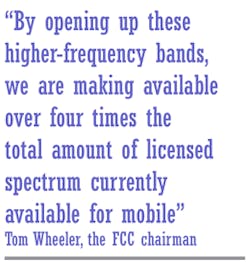The wireless industry is lighting a fire underneath the Federal Communications Commission to open more spectrum for fifth-generation, or 5G, wireless networks. The influence of wireless companies, which are testing 5G systems out in the field, is obvious in its latest spectrum auction. The agency is trying to raise around $84.6 billion for broadcast television spectrum repurposed for mobile communications.
Now the agency is opening spectrum never used before. On Thursday, it approved a proposal that will break ground in frequency bands above 28 GHz, which are also known as millimeter waves. Regulators voted unanimously in favor of the new rules.
Wireless carriers, chipmakers, and equipment manufacturers are piling into the millimeter wave spectrum. In cities, researchers are using high frequency bands and small cells to send data into mobile devices, instead of the low frequency bands and large cell stations driving 4G networks. The higher frequency bands are enabling faster response times, capacity to support massive amounts of devices, and download speeds over ten times faster than 4G. Among the services possible with 5G networks are video streaming for virtual and augmented reality and connecting billions of devices in the Internet of Things.
The rule-making is the latest attempt by regulators to keep pace with 5G testing in the United States. Last month, for example, Sprint tested a wireless network with 4 gigabit per second downloads at the Copa America soccer tournament in Philadelphia. Verizon has already completed its 5G radio specification, while Samsung is making millimeter wave parts for smartphones and cellular equipment. The first networks that the average person can access are expected in 2020.
According to the new rules, nearly 11 GHz of high-frequency spectrum will be opened for mobile and fixed wireless broadband. The licensed bands include 27.5 to 28.35 GHz, 37 to 38.6 GHz, and 38.6 to 40 GHz. The rules also introduced a new band of unlicensed spectrum between 64 and 71 GHz.
“By opening up these higher-frequency bands, we are making available over four times the total amount of licensed spectrum currently available for mobile,” Tom Wheeler, the FCC chairman, said in a statement. The new spectrum bands are 200 megahertz in width, as opposed to current blocks of low-band spectrum, which are usually 5 to 10 megahertz wide.
The new rules make the United States the first country to open millimeter wave spectrum, the agency said. The rules are more flexible that those established for 4G networks, allowing companies to share spectrum for fixed and mobile broadband, as well as satellite and ground communications. “We are setting flexible rules that will allow the market to best determine how the technology will evolve, without having to ask our permission,” Wheeler said. “Without question, 5G is a national priority.”
While the voting was unanimous, several members voiced reservations. For example, commissioner Michael O’Reilly was not satisfied with the amount of spectrum released. “I sought to include more bands,” he said, citing bands 40-42 GHz, 42.5 to 43.5 GHz, and 45.5 to 47 GHz in his testimony.
Following the vote, the United States government said that it would establish the Advanced Wireless Research Initiative, which will have $400 million in funding. The program, announced on Friday, will get $50 million over the next five years from the National Science Foundation and wireless technology companies including Qualcomm, Intel, and Keysight Technologies. The National Science Foundation will commit another $350 million over the next seven years in wireless research.
The funds will be applied to test systems in four cities around the United States. Each system will include a network of software-defined radio antennas, which will mimic existing cellular infrastructure. With the systems, researchers and wireless companies will be able to test and refine wireless components and software algorithms.

